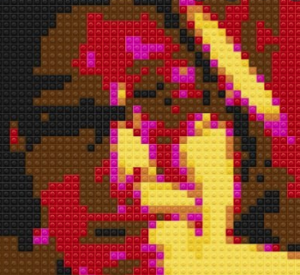
Sirensong: an interview with Jan Peacock (2008)
Mike: While your work is usually shown in galleries, you have also made private, single occupancy art, customized for individual viewers. Could you talk about your Midnight Reader project?
Jan: When the Canadian Art Foundation asked me to donate a work for their fundraising auction, I asked them if they had the right person. Do you mean me? They assured me that people collect video. At that time everyone was making projections, not just video artists any more, but anyone who wanted to make an impression of scale. I immediately thought I’d have to give that up because it had been culturally leveled, emptied of any particular meaning. I’d also been trying to figure out how to present work in a different way. What might people want in their house? How could work address their own experience of living?
I conceived of a continuous line drawing that would encircle the house using only my hand and the video camera and light. I would trace the interior surfaces of the house that were within my reach. It would be installed as a video night light, as I became increasingly self-conscious about taking up space. The actual screen would be only four by six inches. It should be in a space of transition, where the hosts weren’t going to have it always in their peripheral vision. Hallways, stairwells, landings, front halls or porches were all possible. I ran into a little problem with one of the clients who had hired an interior decorator. He thought it was so cool, he wanted a number of them going up the stairs, and another in the dining room. But this would not be a decorative element, instead, a private token and tracing of their lives. Anyone else looking at it might find it nice looking or clever, but only they could really understand how much their lives had changed since I did it. The kids grow up, the drawings aren’t on the fridge anymore, but you still have it on the video, and you have someone touching it for you. Collectors tend to have large houses, so the Midnight Reader tapes run about 90 minutes. That’s how long it takes for me to get around the house, stopping at various details. It’s the only idea I’ve had around customizing work for an individual.

When I make these video drawings in offices, I open drawers and cupboards. This is a trope on the forensic search and the kinds of scrutiny that publically funded institutions routinely undergo. At Latitude 53 (an artist-run gallery), I actually found their annual financial report, which was poignant because the numbers were so small. It was like looking at your own bank account. You could see how the whole operation was run, there was nothing to hide. The office accounting pieces are aimed at a third party to prove that we have access to any necessary information, unlike the closed doors of banks or corporations. It’s a different kind of search than the house tracings which identify things I want the hosts to recognize.
Mike: Do you think of both projects as searches?
Jan: Intention is a convincing fiction that gets you through the door of any idea. I think of Midnight Reader as a huge drawing that consists of light and touch. But when you have that little opening of the camera, you can only think of what’s in front of you, inside the darkness and the slight illumination on the fingertips. You’re just focused on identifying what’s being touched, so the people who live there can say, “Oh, she’s in the first floor bathroom…” At a conference in Copenhagen, I met Paul Wells, Director of animation at Loughborough University School of Art & Design. He said, “That’s animation. The screen/camera is like a shutter, and the whole house is being animated inside that opening. It’s all flowing through that single view.”
This making feels so generous. I’m giving somebody something that matters to them, and it won’t ever disappear like a painting you think you love which you stop seeing after a while. Its meaning will change over the years because of the amount of time that needs to be excavated in order to get to those past moments.
Mike: Reader resolves the traditional divide between production and exhibition.
Jan: It contends with the problem of the indifference of the institutional approach to presenting art. I’m not saying that those involved in presenting are indifferent, I mean that you see people walk by and not even notice. And then you wonder: what am I doing this for? I just helped my partner Steve Higgins install a show of dystopian cities he’s built underneath table tops. He spent the last three years working on five architectural models and they’re now showing in the Confederation Centre on Prince Edward Island. People just walk by, and occasionally glance over. You accept that’s going to be part of the experience of making art, but you do have to have something else going on.
Mike: In Book of Chairs (15 minutes 1997) you engage a row of video-viewing chairs – the kind that used to provide temporary bus station distractions in an exploded living room scenario. What was once private could now be done in public. Where did you find these chairs and what drew you to them?
Jan: These kind of chairs started out in airports, then went down in the world, appearing in train stations and finally in bus terminals. I got my set from the guy who used to service them at the bus station in Halifax. It’s a row of three coin-operated TV chairs. It’s not uncommon for artists to contend with our accidental position as consumers of technology, and resist the push towards planned obsolescence. Everyone is targeted to consume the latest and greatest, but many artists frame their activity as something other than that. When I saw these chairs, I remembered seeing people watch TV in them. I never did, even feeling embarrassed about watching people watch TV, as if I was seeing them in their pajamas. I didn’t realize until I sat down in one that you’re really in your own little world, enveloped and comfortable, and you don’t pay any attention at all to people around you. That was a big discovery.
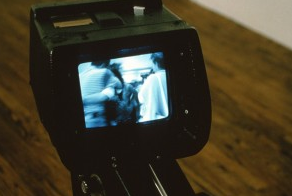
The first piece I did for those chairs required that I stop writing, and I haven’t written since. In the first chair, I showed people at airports meeting in domestic arrivals. I made a series of looped dissolves so you never get to see people arriving, they disappear before meeting. I was trying to measure the emotional equation of anticipation and suspicion. At times people looked like they were thinking, “Are they going to be here? Can I trust them?” I think at times people held back a lot of emotion. The greetings were friendly, but quick, and then the groups would dissolve. It was frustrating not seeing more emotion played out at that site.
The third chair showed international departures. The middle chair was the space between, a mediating and contact space I called Competence. It shows an image of me in my dentist’s chair, and here my writing was replaced by performance. I always had permission to shoot in this office, and I had done it many times before, but now I pointed the camera at myself. I told my dentist that shooting in airports had been difficult and very emotional. Both she and her sister were from England, and my hope was that after introducing the problematics of doing this kind of work, they would start talking, and they did.
I went to International departures because there you find the most honest registration of the fact that many departures are permanent. I taped amazing footage of what were clearly grandparents who didn’t have a lot of money, and were probably never going to see their children again. They kissed their children and grandchildren again and again until everyone cried. It was unlike the Arrivals tape, where I felt free to manipulate the footage and create a completely authored portrait of the emotional tone. I felt I wasn’t allowed to touch the amazing material of Departures, I had to let it be.
I don’t point my camera anywhere that holds an experience that I haven’t had, so there’s a direct empathic understanding. But the fact is, it’s really hard to do, and I don’t know that it can be justified. It’s true that some are also holding video cameras, shooting each other, but I’m outside of their experience, and there’s no way around that. For years, I shot this material whenever I was in an airport and had no idea what I was going to do with it. When I finally managed to get those chairs, I thought, this is an obsolete technology through which all kinds of experience can flow.
The reason I’m in the dentist’s chair is not just because I thought the two women would have an interesting response, but because I also become a subject. Nobody can believe I’m actually shooting it myself, but I have a very steady hand. I had to show myself as exposed and vulnerable while my dentist replaced a crown because I couldn’t really justify the airport material. All I could do is turn it around and create a kind of reciprocity.
Mike: Was something missing in the glossy motion pictures of your youth? Did they fail to conjure every last moment of your world, of the women you would become, the suitors that might lay claim, the work that was to be done? Was there a deficiency that you felt needed addressing, which you would take up with your own pictures?
Jan: My origins feel largely accidental. I was in art school at a period when nobody taught anything. I feel some resentment about that because there’s a lot of undeveloped qualities which I need assistance with, and makes me feel like a bit of an imposter. And regardless of what appears to be the ultimate kind of permission, there’s always boundaries present in people’s biases about certain media, and their lack of information about it.
I had a photo instructor when I was at the University of Western Ontario who turned on the lights in the photo studio and pointed to a cart with a video camera and deck and said, “This is a video camera, and this is how you turn it on.” I would lock myself in the studio on weekends and tell stories and make gestural compositions. I only had one reel of videotape, so I kept recording over what I did. Finally, I had an idea, and started keeping little performative episodes. There was no editing equipment, so I hired a journalism student. It was my first video, and I used it as part of my portfolio for graduate school. When I got there, everybody said, “Oh you’re the video person.” I had twenty slides of sculpture, drawing, photography, and this single videotape. “Oh you’re the video person.”
Mike: Why did they say that?
Jan: I guess it made an impression. It was called Camouflage/Nothing To Hide (22 minutes 1978). I was taking linguistics at the time, so in the tape I was talking about the Saturation Principle. It has to do with how long it takes for a word to separate its meaning self from its sounding self. If you say, “Weiner, weiner, weiner…” eventually it becomes totally abstract, the sound separates itself from the meaning of the word. Linguistics provides a table to measure this word saturation.
The camera framed me without my mouth, focusing instead on a moving chin and neck and a little bit of collar. And then I told a story about wearing a coat with a hole in its pocket. I kept thinking I should fix it, until finally I lost some things because of that pocket, and suddenly I had to turn the coat around and around in front of me in order to really see it. I realized that something like saturation had taken place. I had stopped seeing the coat, and had to rediscover it as a new thing, the way you can hear a word as a new and unfamiliar thing after it’s grown overly familiar. Over time, as I tell the story, the chin and neck become an undulating wave, and disassociate from a face or figure.
In the next couple of years, I met Vito Acconci while he was making The Red Tapes (140 minutes, 1976). When I got to graduate school and produced episodic performances that connected metaphorically, I realized they owed their shape to this work. The Red Tapes is constructed out of vignettes which function independently, as self-contained scenes, but they’re all hooked into each other. It had a huge influence.
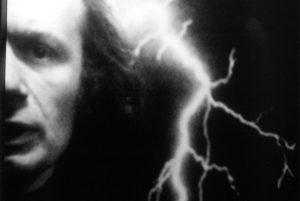
Mike: Did he offer up the prospect of becoming an artist who works with video?
Jan: Absolutely. In The Red Tapes, Acconci layers vernacular language, literary and musical quotations, landscape and architectural photographs, maps, drawings and iconic tableaux to build a psycho-social panorama within which he is both prime agent and subject. “Moving out over the land,” he touches on the master narratives of American identity, from the image cult of the ‘self-made man’ to the post-Hollywood and post-Vietnam fantasies of violence, acquisition and empire. (excerpted from catalogue notes for Corpus Loquendi, Body for Speaking, curated by Jan Peacock Halifax: Dalhousie Art Gallery, 1994) He excavated his resources in a terribly taboo way, you know, talking about sticking his dick into President Kennedy’s head wounds. When I first heard that I could not stop laughing. I’m very far from doing that in my own work, but it was mind blowing that you could say so much with his limited means. There is nothing decorative or overly complicated about his work. He also influenced me to write, his graduate degree was in poetry from Ohio State.
Video was first a small medium. A medium of detail, of proximity, of immediacy, and, above all, of individual reclamation. A camera that jots things down. An eye that mulls thing over. Smallness was never adversity.
When I was in graduate school in San Diego, Marxism was in the ascendant, and many were making social justice work. I felt that my little stories were not so important. But I kept clinging to Acconci’s idea that you could talk about something larger and use the small point in front of you to particularize it. I think that’s a mark of the kind of writers I like to read. They don’t try to talk about the grand thing, instead, they illuminate larger questions through their own experiences.
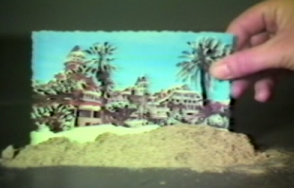
Mike: Did the pre-sweetened offerings of the mainstream never become a reference for you, a place to play out your attraction/repulsions?
Jan: Yes, but there are other uses of visualizing technologies that are equally important. For example, mass media isn’t possible without the military. So much technology research is taxpayer funded, and driven by military needs. Television for instance. Its development was financed by the CIA, and United Brand, which was then United Fruit, and it was all about maintaining control over their holdings, and producing a surveillance technology that they could transport via selective broadcast.
Since its inception, television has produced time models that have become internalized. The 22 minute program, for example. Some artist’s work of that length feels like an entire day. I was part of a generation that was influenced by people who were deliberately drawing attention to these time containers by making very slow and sustained actions, often until the tape ran out. There was no beginning or end, only a slice of time, and that was the material. You can’t do that without referring to television time, which is designed to make time disappear. A lot of people don’t like video for that reason: that time is present again.
Mike: Whitewash (14:15 minutes 1990) is set in a TV studio. Its glossy production offers up a pair of telegenic handsomes turning in their swivel chairs, smiling into their stock phrasings. Modelling gestures they might perform as “real” TV anchors. It offers a semiotic primer, stripped of any content.
Jan: Yes, it examines a finite institutional structure that controls language and perception. I was invited to submit a proposal for something called the Artist’s Television Workshop. Michael Century at the Banff Centre asked: what would happen if you put an artist and a TV crew together? What kind of television would an artist make? After the initial brainstorm, the producers subtracted themselves and it was horrific. For one thing, the crew was very experienced, and used to dealing with experienced directors. When I appealed to them for advice, they would say, “I don’t know. What do you want?” Unaware of union protocols, after spending ten minutes trying to explain a shot, I moved one of the cameras, which caused everyone to walk off set. That night, I showed up at the camera man’s apartment with a bottle of brandy and asked, “Could we please sit down and talk about what’s going on?” His wife was going to be my editor, they were from Poland, and were trying to emigrate to Canada. Everybody was trying to get out of Poland, it was the height of the Solidarity movement, and they were looking for further qualifications and papers. Now they were stuck in a situation that wasn’t doing them any good at all.
Many have spoken about the TV newscasters as two-dimensional; they are surfaces which play out conventions of the medium. If there’s a feature to the female character, it’s that she’s claiming these conventions as her own, that’s who she is. There’s a voice-over that says, “I invent and gather these images.” The male voice replies, “These images are gathered in you, and describe only themselves.” This is a very Baudrillard idea, it’s not a picture of something, images relate only to other images. A sitcom is more like a sitcom than anything else. It’s a closed, self-referential system.
I never thought of the project as a wedge to begin working in TV, though others did. Some wondered: how are you going to keep her down on the farm now? It looks so good, you’re never going to be able to go home again and work with your little Hi 8 camcorder. But it’s not true. I consider a technological array for each project, resisting the impulse to be addressed as a consumer of the next best thing.
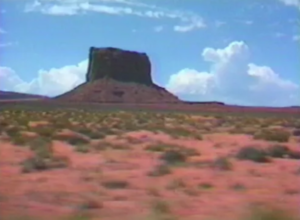
Mike: In Sirensong (8:30 minutes 1987) the promised land and landing is already a picture. The plane ride and desert landscape offers us an image of the traveler: displaced and surrounded on all sides by pictures she already has in her mind. There is the sense that she never really lands, that she is only moving through pictures, even the ones she brings home inside her camera shield. Why did you choose to shoot in Arizona’s Monument Valley, the setting for so many iconic John Ford westerns?
Jan: It was the second choice really. I went out there to shoot the Grand Canyon. Every once in a while we would stay in a hotel to charge batteries, and I would look at the footage and it was clear I wasn’t getting anything. Hi 8 video flattened out the landscapes and turned them into colour field paintings. I wanted to have an iconic landscape possessed of a popular presence equal to TV, so that people who had never been there already felt like they knew what it was. I thought the Grand Canyon would be great, but it just didn’t work at all. And then we happened to go to Monument Valley, and I realized if I pointed the camera down into the red dust and then tilted up through the dry air into the horizon, it’s the horizon that’s iconic. That’s when you lose your body and become a witness to the entire history of that image, rather than being there on a camping trip.
I walked and shot and wrote there for, I believe, four days, and continued to walk/shoot/write throughout Arizona, New Mexico and California for another week. Before and after having driven, camped, cooked, had the car repaired, dreamed, argued, made love, read Anasazi history and taken tea with fellow tourists, writing and shooting remained hopelessly specialized and self-isolating acts, exactly contrary to the project of immersion. There may be some who can operate simultaneously as both observers and participants, but I can only produce myself sequentially. Only following the last communal embrace can I “leave” for work. “Going” to work is, of course, immersion, but in a place that is necessarily different from the place as lived.
I returned to New York and began logging my footage, making notes, transferring some material to 3/4” tapes for editing. And I continued to shoot — the kitchen sequences, the crowds at the World Trade Centre, the televised moonwalk footage — as well as many other images that did not make it into the tape. I remember, in particular, a full day on the Staten Island Ferry, and several days in the Wall Street district. (Down near Wall Street, the screeching sound of a car suddenly braking became the aural fulcrum, six years later, between the willow over the Seine and the tourist boat in Reader by the Window.)
In several different on-line suites, I began to assemble some picture sequences that seemed to require dissolves, polishing and tuning even though I had little idea of where these would end up within the body of the tape. And I continued to write, quite apart from the editing and shooting activities. Back in Halifax, about a month after leaving Arizona, I began to write in earnest (that is, in a way that could be spoken), and often in the edit room, so that I could read aloud as I played through both raw footage and semi-completed picture sequences, trying out my voice with the writing, timing written material to visual material, editing sound to image. Some segments of the writing were developed as mixed-down, four-channel soundscapes, which I laid in on a section of video black track. Then I would comb through my footage archive, trying to inscribe the sound sequence with a picture sequence. Sometimes sound proved more narrative than the image, and vice versa. In the midst of this, a deadline began to loom large. When this happens, I have to trust that I have enough history with the piece (and that it has enough of mine) to not agonize over every small decision. I have no recollection of having finished the work. (footnote here: excerpt from (In) Script by Jan Peacock, Manuscript of an essay about the making of the tape Sirensong, commissioned by Steve Reinke and Nelson Henricks for the book By the Skin of Their Tongues, YYZ Publications, 1997)
As Debord writes in The Society of the Spectacle (1967), we prefer the image over the experience because it’s controlled and offered up without having to do anything, which is not really how experience works. Three years prior to this trip I went to France for the first time with a friend. We were at the Palace of Versailles looking down at the pool and he kept picking up his camera and putting it down. I asked, “What’s the problem?” “Well,” he said, “I could take THAT picture.” And I thought, he’s right. It’s not a place, it’s a picture.
Mike: Would you say the same of moments that have been replayed for many of us again and again, like falling in love? Are these rehearsed intimacies also pictures that inhabit us?
Jan: Yes, there’s a lot of personal disappointment that experience isn’t as glamorous as the regime of Hollywood images. Cathy Tenney is a former student who made a videotape about this called Spin Off. It opened with these lines, “I can’t remember the names of all the men I’ve ever slept with, but I can sing you all the words of the Brady Bunch song.” It continues, “A friend of mine thinks the universe is infinite. Personally, I think it’s about a six block radius. Once it’s filled up, there’s no room for anything else.” She takes footage of Mary Taylor Moore and JR Ewing from Dallas and makes them have an affair. How disappointing and small one’s own life is by comparison. The last line says, “While you and I are making love, they are gesturing into infinity.”
Mike: Do you feel your work is an intervention against, or partial antidote, to those viral mainstream pictures?
Jan: Well, certainly Siren Song was meant to be that. How can I experience something when so many images of it precede my encounter? How can you have an original, first-person experience when most of your time is involved in recognition?
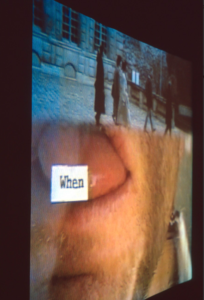
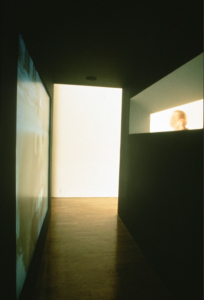
Mike: This Walk, These Steps (5 minutes 1995) is a split-screen work; what else to expect in a love story except for top and bottom, public and private? While passersby stroll through a stony terrace on the top screen, below them, a couple attaches words to a glass in front of the lens, one word at a time, using their tongues. “I/am/using/these/words/to/count/the/days/until/you/leave.”
Jan: Do you think the two screens work?
Mike: I can’t help making a story out of this insistent juxtaposition. The terrace must be the space the lovers first met, or where they are forced to see each other after it’s over.
Jan: I take the public footage to be more of a paradigm, a model constructed to show a false intimacy. The only change I made is that whenever people walk in proximity to a stranger, I slow it down, so it looks like they’re pausing to stop for each other. It’s a fictionalized intimacy in a space that is without contact, external to the groups that they’re in.
The male and female performances have single words printed on paper on the end of their tongues, and they’re sticking them to glass. It was shot weeks apart, but they’re edited together with very tight dissolves that makes it seem as if they’re in the same space at the same time. They’re not talking to each other, they’re simply delivering words which are at once aggressive and withholding. Here is an intimate context in which intimacy has been defeated.
I had written a bad poem on the occasion of a bad break-up, and lived with it for almost seven years. I have the same relation with my journal as my video archive, I can reach into it and decide what material is useful for a new project. I took the poem and pulled it apart into language which one or the other would say. Then I discovered that you can’t use inkjet text on the end of someone’s tongue because it just dissolves. I had to photocopy the lines and cut them up, and then chance operations intervened in our partial retrieval of the original sentences. The editing process allowed us to re-order the lines once again. I love editing because it feels like writing, it’s the same kind of shaping of possible meanings. That was very satisfying. I can’t imagine working within editing formulas that produce, for instance, platforms for TV news delivery. But editing as an invention, as a completely animate set of possibilities for anything you touch with video, that’s when things really come alive. I can have the most ordinary material, but editing is what makes it sing.
Mike: Why did you stop writing?
Jan: Well, I’m curious to see if it comes back. For years I felt I was manipulating the viewer with my writing. I didn’t feel there was anything particularly compelling about the way I shot, and I wondered if I was really a visual artist because there was something so deeply rhetorical about what I was doing.

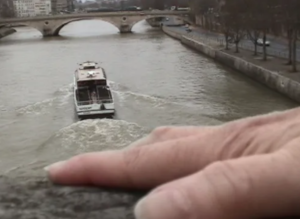
Mike: You’ve made several tapes which feature your hand in close-up running over surfaces. In One Same, Same Thing (7:30 minutes 2003) your wounded and bandaged hand runs over endless roads of small stones. there there (5 minute loop, 2009) offers up a lighter mood as your hand touches up a Paris bridge. Both camera and bridge are hand-held, offering a travel without arrival, an image of displacement that is also home.
Jan: In 1980 I was in graduate school and made a piece called News from the In-Between (19:30 minutes 1981). I looked up “in between” and the dictionary said that it was the point that connects and the point that divides. How can that be? Bridges have that quality, as well as stairwells, and I do a lot of walking in those passageways. The bridge that I’m on is the Pont Marie in Paris, and it connects the Right Bank with île Saint-Louis. I could record my hand crossing bridges endlessly, trace people’s houses endlessly, search offices endlessly. Whenever I do it, it doesn’t dissipate the sense that when I see the next bridge or office, I don’t have to do it again.
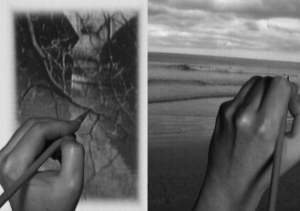
Mike: In Reader by the Window (15:37 minutes 1993), the tape description says that this work is made from a series of “video landscape walks recorded over a six year period in Canada, Japan, France, England and the US.” Do you take your camera out for a breeze the way others stroll their pets? For exercise, or as a form of sketching?
Jan: When I shoot, I often record under a particular category that I’ve started collecting, but not for any specific project. Reader was the first time I recognized that there were patterns in these many walks. One of the things I’d started to do were these landscape spins, turning back and forth, as if trying to scan at a super perceptive speed. But you can’t make anything out, it becomes a blur. When I started looking into previous years of shooting, across many different formats, it recurred again and again, though I had no idea I’d been doing it. While working with composer Brian Aisles on the tape, we called these dissolved-together spins “the knots.” It’s where everything seizes up, and you aren’t in the landscape or in your body. There were other similarly recurring patterns, I couldn’t believe how predictable I was! I remember working with Allan Kaprow in San Diego when he said, “You are more like yourself each day than you are like anyone else.” That’s another place where you can talk about intention being a fiction. The intention might lay bare the pattern, but it already exists, long before you had the intention.
An artist may sustain a body of work as an ecosystem, in which every part is used to every advantage, not consuming any part without regenerating it. This approach suggests a fictional level of attention and attentiveness, bordering (romantically) on surrender. But, in purely practical terms, if you ever want evidence of what kind of artist you are, or even the kind of person, you need look no further than how you spend your time. The ecosystem of discovery/making/discovery hinges on one’s attendance to unique experience, transposing behaviours and reactions and events into useful projections (objects, images). Naturally, patterns emerge through repetition, and repetition yields up a type of discovery that reveals everything about itself, especially its sorry limits.

Less than a month after my friend Peter had his ashes cast into the ocean near the Louisburg lighthouse on the southeast coast of Cape Breton, I heard a philosopher on the radio saying that he would bury his beloved dog on the farm she so enjoyed, but would stop short of erecting a headstone on the burial spot. This would “sentimentalize” the relationship in a way that took dignity away from the dog. “Animals must be animals,” he said, and this seemed a notion he could live with. And I wondered about how we are able to reflect on matterlessness and mattering, and about the associative values of affixing a monument of stone, making a private grave from earth alone, or burning and diffusing remains using wind and water. Stone, earth and fire, wind and water, in these gestures, all produce an idea of ongoingness, if not permanence, joined as they are to the gesture and memory in a living body.
Peter had a large commercial print of a painting. A few days before he died, he had a friend bring it from his apartment to his room in palliative care. It hung on a wall at the foot of his bed. He loved this painting, of a shadowed room with windowed doors flung wide open to the sea and sky, curtains billowing inward, a glowing wood floor that dropped off into space below the water’s horizon. I said, “That’s really beautiful, Peter.” He shrugged, pointed to the painted horizon, and said, “It’s where I’m going.” (“presence,” essay written for Point and Shoot, eds. Michèle Thériault and France Choinière, Editions Dazibao, Montréal 2005)
Mike: Your work largely refuses storytelling.
Jan: And yet, I can’t tell you how much narrative theory I’ve devoured. I have to know about it in order to disassemble it. But I’ve never been interested in beginning, middle and end. It’s all middle. There’s too much mortality in the offing to go to the end. It’s just going to be about this moment, and what it makes you think about. Let me tell you a story.
I was in Edmonton where an ex-student was curating a show. She told me about a friend of hers who was asked to look after a dog while the owners were away on vacation. The German Shepherd was large, aged and decrepit. Sure enough, doesn’t the dog die while they’re away. She panics until she’s finally able to reach them, and they give her the vet’s address, assuring her that he will know what to do. The problem is, she doesn’t have a car, and the dog is too large and stiff to fit into a taxi. So she puts it in a hockey equipment bag and drags it to the bus stop. She waits there until a stranger approaches and asks, “That looks really heavy, what on earth do you have in there?” She replies, “Oh, I’m going over to my boyfriend’s house because he fixes computers. I have a hard drive…” At which point he grabs it out of her hands and takes off. She is forced to call up the owners a second time and tell them that they won’t be able to see their dog again, not even the ashes.
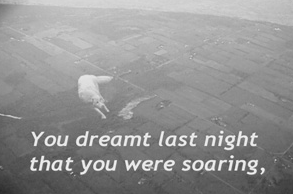
Mike: There’s so much video being produced now, even the bounty of the past which used to be difficult to access is being delivered by the internet. What is the point of producing pictures in this time…
Jan: … when everyone does it? I think it’s still important. Have you ever browsed viewer comments on You Tube? It comes from the reptilian brain. But this (points to front of head) is where we are when we make work. While shaping and articulating, there’s so much more going on than grunting and pointing at things. If I thought we were all equal because we all had access to the same technology…
Mike: Wasn’t the earliest dream of video art that the tools of production and exhibition could be freed from corporations, and that everyone could do it? Cell phone cams and the internet have gone some way towards realizing these dreams.
Jan: Isn’t it awful? I never bought into that. When I was in with the Marxist/socialist crowd at USCD they had these utopian ideals about technology. The digital promise is filled with tools that are more or less useful. There’s nothing innately redemptive about technology.
Access, in technology, has no time to it — it is a present, open channel. You get access, and you have access, just as you get and have any other commodity. “Global access” is stakeholder-speak for a small, subscriber segment of the planet, for whom access is not a ruminative, experimental, complex, attenuated, and failure-riddled process — not a process at all, in fact, but a service. A simultaneity of expectation and supply is built into this obliteration of time. Our inability to conceptualize metaphors of time which relate the body to technological processes has helped to produce a culture of entitlement.(excerpt from Ready Access by Jan Peacock, Public 25, ‘Experimentalism,’ ed. Gary Kibbins and Susan Lord, 2002)
Mike: But, on the other side, doesn’t showing in art galleries relegate your work to the exclusive attention of other artists?
Jan: I think that’s true. We’re much more interested in seeing each other’s work. There’s a predisposition to being attentive and looking for something. It’s a product of habit and training and remains a specialized discourse.
Mike: Is it enough?
Jan: No, that’s why I started making private work. There is a soul-killing indifference to showing in institutional space, and you have to wonder if the work isn’t being overly shaped by that destination container. What would it mean to take your work outside the gallery and negotiate something completely different? But I’d rather be in a museum or gallery than a festival. They’re just for parties and networking. The whole history of culture creates events as a way to socialize, but the kinds of things I make need to be thought about privately. I like the idea of a DVD, or a video book that can offer multiple entry points. Do you know the Brian Eno/Peter Handke Oblique Strategy cards? There’s many online versions – if you’re having problems clearing the deck, that’s one place to start.